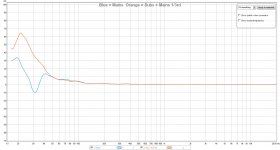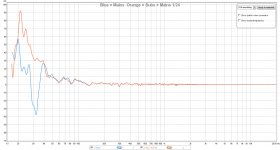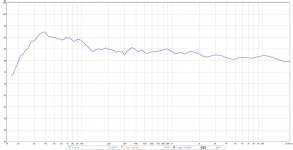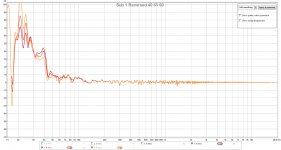what happens GD wise with a typical 6th order reflex with qts~0.31 and active Q=2 boost (underdamped 2nd order highpass) ~1.03*fb? - lets say the reflex fb ~30Hz
it's up there, but at frequencies 2 x tuning frequency, the sub has the same delay as a sealed. So at 60hz, a 27hz ported would be just as "fast" (I hate that word for bass). Listen to 2 subs by themselves and tell me which one is quicker. You won't, it will all sound like mud.
I really don't think it is a problem (compared to a deep sealed), my dual 12" 6th order 27hz ppsl went deeper, cleaner and faster than my buddy's 3x10" sealed Jl audios.
Now, changing 40hz tuning to 27hz (by plugging one of the 2 ports on my jbls), that changed the bass from thunk thunk to boom boom (definitely better).
Biggest offender (to me) is the 80-100hz crossover (espevcially 12 and 18db) and the phase shifting around it. If I remember, an 80hz crossover had 15mS of delay at 50hz and having less the lower you went. Meanwhile just over 80hz came way too soon.
I really don't think it is a problem (compared to a deep sealed), my dual 12" 6th order 27hz ppsl went deeper, cleaner and faster than my buddy's 3x10" sealed Jl audios.
Now, changing 40hz tuning to 27hz (by plugging one of the 2 ports on my jbls), that changed the bass from thunk thunk to boom boom (definitely better).
Biggest offender (to me) is the 80-100hz crossover (espevcially 12 and 18db) and the phase shifting around it. If I remember, an 80hz crossover had 15mS of delay at 50hz and having less the lower you went. Meanwhile just over 80hz came way too soon.
It is important to keep it as low as possible at the 40Hz-50Hz region as that is where the kickdrum is centered. The timing and rhythm of much rock and jazz is governed by the kickdrum and the 41Hz of the bass guitar.
The "kick" from the kick drum comes from the higher harmonics around 80-150 Hz. Sure it's nice to have a good fundamental beneath it but the impact is higher up than one would think. Not a wisdom I acquired myself but actually hinted at by guys on the diy mobile audio forums like Andy Wehmeyer formerly active for JBL.
At one point I actually chased the kick in the chest in my car. The response at 40-60 Hz is easy to get to high levels in a car. But that never gave me the kick in the chest, it wasn't until I raised the sub's low pass to ~150 Hz (all time aligned with mid bass speakers of coarse) that I got to experience that kick. It was highly distracting while driving a car though 😱.
Jim1961 results in room look very good to me at the listening spot. But I think the arrival of the first wave determines the sense of timing. Look at a gated plot and see what the GD line looks like gated at ~50 ms. No way I could get a clean group delay at the listening position like the one posted by Jim due to room disturbance. Yet the timing from my arrays feels very accurate.
I bet drums sound very convincing with the plot shown, at the right SPL levels and with a good FR plot to go with that GD plot.
I agree that the 80Hz to 100Hz range for the 2nd harmonic of the 50Hz kick drum is how most speakers play the punch (because they don't have bass extension). The OP's system is quite good there alread (as can be expected from a high end TG design). But since he is chasing better timing, it seems that the GD of the fundamental in 40Hz to 50Hz range is where there may be some room for improvement. When you get that fundamental pulse to be time aligned and have low GD it sounds a lot better.
You do realise this was a measurement at the listening position right?
Very different from one half a meter away from a speaker. Seeing as how 3 subs are involved I'd say only time alignment of the subs to the mains could improve that.
But the room will still mess with a group delay measured at the listening position. If you look at a gated measurement, you'd take away some of that effect.
But how big are the chances all subs and mains are currently at exact the same distance from the listening spot? Regardless of their configuration?
Time alignment could improve things, but it isn't as easy to time align subs as it is a tweeter to a mid.
Maybe we should see a graph of only the mains to see what that is doing, as they are ported as well.
Very different from one half a meter away from a speaker. Seeing as how 3 subs are involved I'd say only time alignment of the subs to the mains could improve that.
But the room will still mess with a group delay measured at the listening position. If you look at a gated measurement, you'd take away some of that effect.
But how big are the chances all subs and mains are currently at exact the same distance from the listening spot? Regardless of their configuration?
Time alignment could improve things, but it isn't as easy to time align subs as it is a tweeter to a mid.
Maybe we should see a graph of only the mains to see what that is doing, as they are ported as well.
Last edited:
I agree that it is a mess with how many speakers are involved which was why the OP wanted to see if there is any low hanging fruit that can be used to reduce the large 20ms GD at 40Hz. Given that there are multi sources and some are ported and some are not, and it is at LP, I would have to say that the data actually looks pretty good. It looks like the OP has done quite a bit of room treatment already otherwise it would truly look much much worse.
The "kick" from the kick drum comes from the higher harmonics around 80-150 Hz. .
Yes this is correct. That's basically how transmission line's can still sound good. The kick is made entirely of upper harmonics. If you superimposed a sinewave at 50 Hz onto the time profile, starting at the kick, you would see exactly what I mean - it does just not have time to cut in with the 'kick'.
What you infact get from a sub is the lower frequencies with upper harmonics stripped out so it approximates a sine wave.
I can generate sinewaves on my keyboard with an instantaneous envelope at 50 hz and there is no kick at all - just a low rumble, whereas I clearly get the explosive sound with real instruments/music.
It's something that few people appreciate. What you really do need, however is such low frequencies arriving roughly in phase or you will get some very unpredictable results - dropouts and peaks.
Yes this is correct. That's basically how transmission line's can still sound good. The kick is made entirely of upper harmonics. If you superimposed a sinewave at 50 Hz onto the time profile, starting at the kick, you would see exactly what I mean - it does just not have time to cut in with the 'kick'.
What you infact get from a sub is the lower frequencies with upper harmonics stripped out so it approximates a sine wave.
I can generate sinewaves on my keyboard with an instantaneous envelope at 50 hz and there is no kick at all - just a low rumble, whereas I clearly get the explosive sound with real instruments/music.
It's something that few people appreciate. What you really do need, however is such low frequencies arriving roughly in phase or you will get some very unpredictable results - dropouts and peaks.
Drum Frequencies of Kick Bass Drum, Hi Hats, Snare and Crash Cymbals

Yes good graph, showing the spread of frequencies but unfortunately it does not show what's going on in the time domain 30-50 Hz fundamental vs higher frequencies so does not demonstrate what you are hearing in terms of the 'kick'
Here is a question/thought. What is the true phase of a ported speaker? What I mean is, you have the direct positive response of the woofer itself. Then you have the port energy (delayed). So in a sense, you have two crests at different times resulting in a new crest being the resultant of the woofer and the port. Do I have this right?
So the question is, when trying to marry a sealed sub (with no port delay) to a ported speaker in terms of timing, would you want the distances to be the same?
Wouldnt the resultant crest of a ported speaker be later than a sealed speaker at the same distance?
If the port energy is 360 out of phase with the woofer, would the resultant energy crest be 180 degrees delayed for a ported speaker? If this is true, a sealed sub at the same distance would need to be reversed polarity (180 degrees out of phase) to coincide with the timing of the ported speaker?
So the question is, when trying to marry a sealed sub (with no port delay) to a ported speaker in terms of timing, would you want the distances to be the same?
Wouldnt the resultant crest of a ported speaker be later than a sealed speaker at the same distance?
If the port energy is 360 out of phase with the woofer, would the resultant energy crest be 180 degrees delayed for a ported speaker? If this is true, a sealed sub at the same distance would need to be reversed polarity (180 degrees out of phase) to coincide with the timing of the ported speaker?
Last edited:
The answer is a ported speaker will usually have a phase delay of 180 degrees (but you are using the rear of the driver wave which is already 180 degrees out of phase) so the resulting sound (at the tuning frequency) is delayed but in phase.
The problem arises at higher frequencies - that's why you don't want any higher frequencies coming out of the port ideally - they will dilute the 'punch' significantly as they won't be exactly in phase with the driver output (the port provides the correct delay only for the tuning frequency).
Yes you do want to match distances of the sub and main driver to maintain phase unless you have a phase adjuster built in so you can change it manually.
The problem arises at higher frequencies - that's why you don't want any higher frequencies coming out of the port ideally - they will dilute the 'punch' significantly as they won't be exactly in phase with the driver output (the port provides the correct delay only for the tuning frequency).
Yes you do want to match distances of the sub and main driver to maintain phase unless you have a phase adjuster built in so you can change it manually.
The problem arises at higher frequencies - that's why you don't want any higher frequencies coming out of the port ideally - they will dilute the 'punch' significantly as they won't be exactly in phase with the driver output (the port provides the correct delay only for the tuning frequency).
Define "higher frequencies" in this context.
Anything higher than tuning frequency in theory but most noticeable above 100 hz
Pretty much any muti-way ported speaker is going to have port output above 100hz.
In my mains, by clogging the ports and comparing FR, ive got port contribution up to about 180hz 🙁
In subs though, low tuning and XO frequencies can eliminate this.
Rear facing ports help somewhat
Nope. Mine face front.
As well as having lots of damping on walls inside cabinet.
Yup.
the OP wanted to see if there is any low hanging fruit that can be used to reduce the large 20ms GD at 40Hz.
Quite accurate and nice phrasing. 🙂
I suppose the trees are bare down low it seems.
Last edited:
- Status
- Not open for further replies.
- Home
- Loudspeakers
- Full Range
- Group Delay Questions and Analysis




